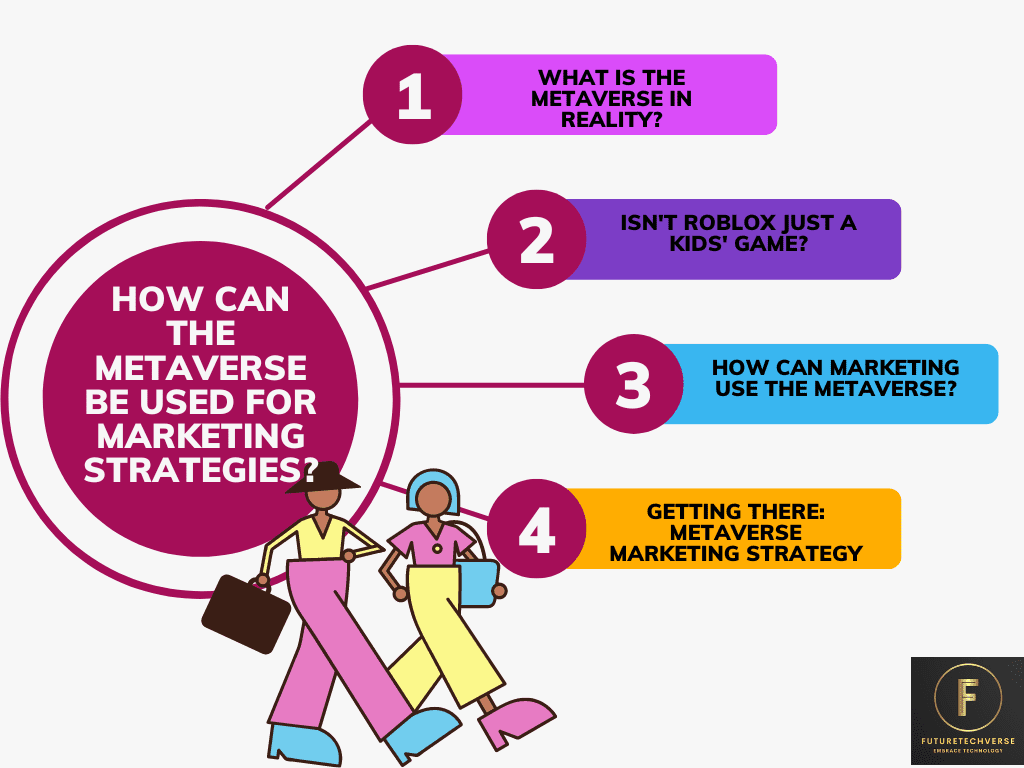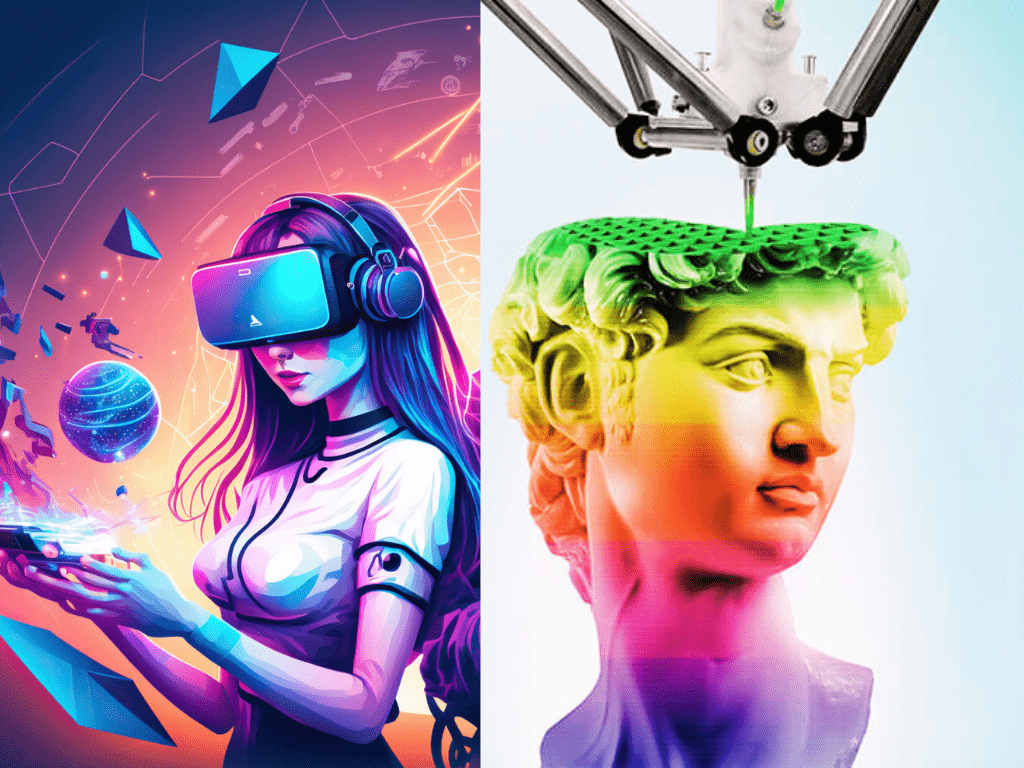The metaverse marketing strategies are one of the best upcoming potential technologies in the world. Due to severe anxiety, agencies and brands hustled to understand and put into effect some sort of metaverse marketing strategy.
While the typical customer simply questioned, “What exactly is the metaverse? And why would I spend hundreds of dollars on a VR headset to just see a cartoon version of myself?” others even employed Chief Metaverse Officers with huge salaries.
Then everything came to an end. Bitcoin fell off an edge. NFTs have lost their appeal and shine. Some people claim that the entire “blockchain revolution” was largely marketing, not the metaverse, though.
It’s here to stay and, in my opinion, it presents an incredible chance for branding.
What Is The Metaverse in Reality?
With FutureTechVerse, you will get a complete understanding of Metaverse.
Just clearing up some misunderstandings, the metaverse is a wonderful place, to begin with your imaginary world. Though the idea of the metaverse may sound “out there,” it is actually rather easy to understand:
There are various metaverse examples in the market, however, it is a digital platform containing both ownership of assets and shared or personalized virtual experiences is known as a metaverse. Digital self-representation (avatars) and some kind of marketplace currency and exchange are strongly highlighted.
That is all a metaverse is, to put it simply.
In spite of the fact that VR-enabled experiences are certainly more engaging, none of them are requirements for a metaverse platform.
Finally, you would need both a large user base and adjustable developer experiences to be regarded as a genuinely excellent metaverse platform.
Any platform with even hundreds of thousands of users will struggle to reach critical mass because people want to be where other people are.
During the NFT chaos, just a few platforms—primarily The Sandbox, Decentraland, and Roblox—received all the attention. While practically every platform can benefit from our digital agency’s assistance in developing a client’s metaverse presence, in this piece I’ll primarily focus on Roblox.
This metaverse platform has had the biggest marketing strategies, and influence because of its large user base, compatibility with most devices, and ability to provide artists with an open environment in which to build whatever they can imagine.
Considering Roblox And Other Things
“Isn’t Roblox just a kids’ game?” is a typical response we frequently hear. However, that is somewhat accurate.
- 23% of users are actually under the age of 16.
- While a third of users (or around 20 million daily users) are above the age of 16,
- 14% of them are 25 or older, even though two-thirds of users are in fact under the age of 16.
Brands should understand this as meaning that if kids or young adults make up your target market, this platform may be a good place to start building interaction. The vast number of users and their involvement, however, give a significant opportunity for brand visibility even for businesses whose target market is not young people, like Gucci.
The metaverse, whether it is on Roblox or another well-known platform, is fertile ground for extending nearly any brand’s reach to a global audience, so long as the correct combination of creativity, research, and strategy is used.
Since there are many different kinds of enterprises for which Roblox would be unimportant, I say “almost” rather than “exactly.” A more corporate metaverse (such as Decentraland) would probably be a better fit if B2B, C-level, or other similar target audiences are your main focus.
How Can Marketing Use the Metaverse?

Making branded resources is the simplest metaverse marketing strategy. You can design these asset(s) using common 3D modeling software and then make them available to all users in their experiences, in Roblox’s instance via the Creator Marketplace. The low entry barrier is a benefit of this strategy, but the potential for low involvement is a drawback.
- Realistically, creating a customized experience that is publicly or privately marketed is the most successful (though resource-intensive) method.
- Some businesses or tourist sites duplicate their in-person experience digitally.
- Others design environments with mini-games, incentives, and badges connected to users’ achievements to boost “stickiness.”
A strategy for attracting users is essential once your experience is ready to launch (after multiple rounds of user testing and feedback implementation). Users can choose from a huge variety of experiences, so advertising is essential. You can easily advertise your experience for users on the Metaverse platform’s Home or Explore screens directly within Roblox. Additionally, you may submit simple static ads and bid with Roblox on a very easy PPC (pay-per-click) interface.
You can even promote your experience outside of the platforms if you have the desire for advanced and detailed advertising. By identifying their target market, raising awareness, and encouraging people to return to their experience, marketers have successfully used YouTube Ads and even Reddit to increase visibility.
Getting There: Metaverse Marketing Strategy
It’s simple to start. All you need is a free account on the platform of your choice, and if that platform is Roblox, you also need Roblox Studio. However, it’s typically advised to collaborate with an experienced studio that can lead you through the process—from idea to storytelling, all the way through to MVP and advertising management—to ensure a higher possibility of success in achieving your metaverse KPIs.
Your brand: is it ready? The metaverse is waiting!
Frequently Asked Questions:
What are the key benefits of using the metaverse for marketing?
Using the metaverse for marketing offers several benefits, including:
- Enhanced customer engagement
- Personalized experiences
- Expanded reach and accessibility
- Data-driven insights
- Innovative storytelling
How can brands and businesses establish a presence in the metaverse?
To establish a presence in the metaverse, brands can:
- Create virtual environments
- Partner with existing platforms
- Develop branded experiences
- Invest in metaverse advertising
What role does virtual reality (VR) play in metaverse marketing?
VR headsets enable users to enter a virtual world and engage with brands and their offerings on a more realistic and engaging level. It allows for virtual product demonstrations, virtual showrooms, virtual events, and other interactive experiences that bridge the gap between physical and digital realms.

